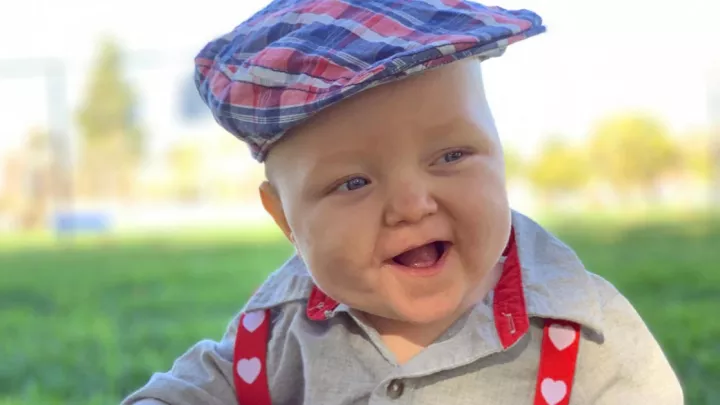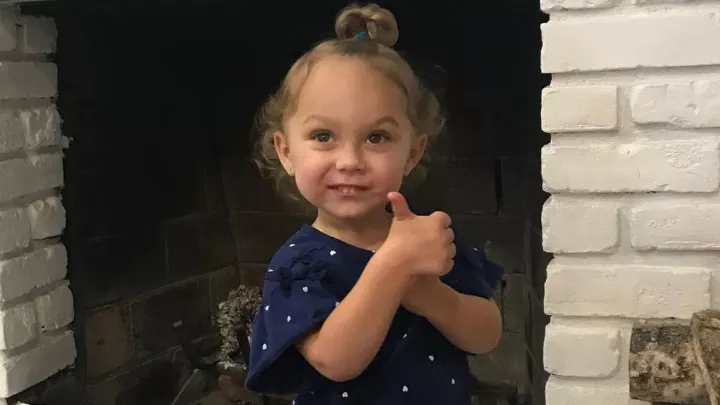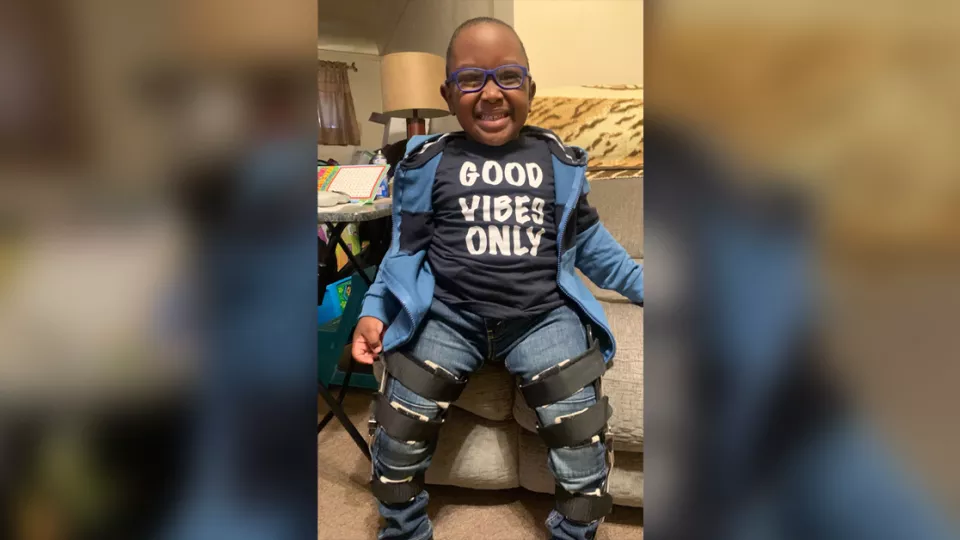
Meet the New Student at ‘Abbott Elementary’: CHLA Spina Bifida Patient D’Kai
The journey from spina bifida patient to child actor isn’t typically done in one week’s time, but after charming the producers of “Abbott Elementary,” 4-year-old D’Kai found his life’s course swiftly set off in a new direction. Even if he hadn’t been waiting for his big break, he was happy to take it when it arrived.
Quick backstory: D’Kai’s mother, Jazmin, learned that “Abbott Elementary,” the celebrated ABC comedy series about a group of teachers at an underfunded public school in Philadelphia, had released a very specific casting call. The show needed a child with a disability who used a wheelchair.
D’Kai met both requirements. Born with spina bifida, an incomplete development of the spine, he had been treated at Children’s Hospital Los Angeles since infancy. He lacked one attribute—acting experience. But he had other qualities: He was a bright kid with a lot of personality, and being 4, he was up for anything.
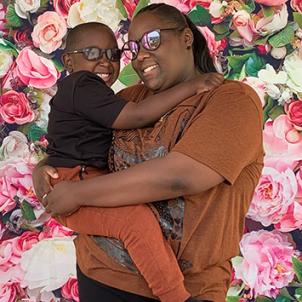
“We jumped on the opportunity,” Jazmin says. “I talked to him about it, and he was like, ‘OK, I’ll try it.’”
They submitted pictures, interviewed with the casting team, and D’Kai, as they say in his new trade, booked it. “Everything happened in a week,” Jazmin says.
It’s a nonspeaking role. D’Kai, now 5, is visible in the background of some classroom scenes. But who knows where it may lead? Beware, Brad Pitt’s career launched with a Pringles commercial. D’Kai’s breakthrough makes perfect sense to his doctors at CHLA, who call him bubbly, engaging and ideal for the screen. To see him on their TV sets in the cast of “Abbott Elementary” drew little surprise, but a lot of gratification.
“Children with different abilities, especially children from minority communities, is not something we see often on television,” says orthopedist Melissa Bent, MD, one of several physicians who manage D’Kai’s care. “So having D’Kai be part of that even bigger movement of visibility, to me, was very rewarding.”
The night D’Kai made his first appearance on the show (search Season 2, Episode 1) was “a joy,” Jazmin says. “I was just amazed. ‘Oh my goodness. You’re really on TV!’ He was so happy. He was like, ‘Look! It’s me, Mom! Look at me! I’m right there!’
When the spine doesn’t close
You learn something new every day, and today that new something will be sequelae. “It means the consequences of the diagnosis for a medical condition,” Patricia Castillo, MD, says.
A specialist in the Spina Bifida Program at Children’s Hospital Los Angeles, Dr. Castillo has treated D’Kai since April 2018, when he was 4 months old. There are multiple versions and degrees of spina bifida; D’Kai has the most severe form, called myelomeningocele, wherein the spine does not close properly, causing what looks like a bubble to form at the opening, sitting on the baby’s back, outside the skin and its contents unprotected by the spinal column.
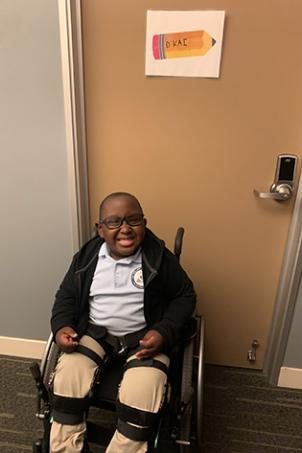
“What ends up happening is,” Dr. Castillo says, “those contents in that bubble—the portion of the spinal cord and the nerves that are attached there—are exposed to amniotic fluid during the pregnancy, and that can lead to severe complications. With the form of spina bifida and the level of spina bifida that D’Kai has, it’s not uncommon to see all of the sequelae that he does have.”
Those sequelae afflicting D’Kai include hydrocephalus, the backup of cerebrospinal fluid in the brain; incontinence of the bowel and bladder; and lower-body weakness to the point of paraplegia—the inability to feel or move one’s legs.
“We don’t have treatments that repair spinal damage or the differences that patients are born with,” Dr. Castillo says. “What we try to do is optimize what we can to help them live functional and productive lives.”
To that end, D’Kai has a shunt installed in the ventricles of his brain to carry away the excess cerebrospinal fluid that accumulates there. He uses a catheter to drain his bladder after he wakes in the morning and before he goes off to sleep at night, but otherwise goes without it. Though he has no feeling below the knees, he can walk some with the aid of leg braces and a walker. He was born with clubfoot that was corrected through treatment.
Dr. Bent handles D’Kai’s orthopedic care through the Jackie and Gene Autry Orthopedic Center, including working to ensure his feet, now straight, don’t turn back inward. She says her primary goal with children with spina bifida is to get them to adulthood able to carry out life’s daily functions, without any permanent deformities developed in their knees, feet or back.
“He’s doing great,” she says of D’Kai. “His foot hasn’t relapsed. He’s had no problem with his braces. He doesn’t have any fixed deformities. So orthopedically, he looks fantastic.”
‘That’s not all you are’
From the moment she was told his diagnosis when she was 20 weeks pregnant, Jazmin resolved to create a meaningful life for D’Kai, and not one whose course was determined by his disease.
“My mindset was, it’s not going to define him—period,” she says. “Yes, you have a disability, but that’s not all you are. You have a disability and nobody sees anything else? I wasn’t going to let him feel like that. It’s not going to be a crutch. ‘Oh well, because I’m in a wheelchair, I can’t’—no, that’s not going to be you. I made sure he has a positive attitude and that’s how we’re raising him.”
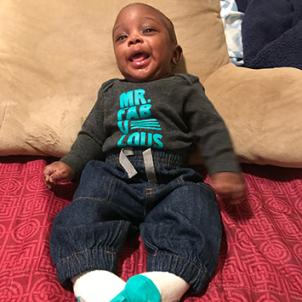
“He walks with a walker or with assistance from us, but he gets on the floor and he crawls everywhere and he doesn’t need help. He’ll tell you, ‘I got it.’ He plays with his toys. He loves music and books and different things. So he’s not limited. I just try to make sure I’m doing all I’m supposed to do so he’s OK and safe and happy.”
Dr. Castillo sees no reason to downsize expectations for D’Kai. She says spina bifida generally doesn’t affect cognitive function or cause intellectual deficits, even if it creates the need for a shunt to be placed in the brain.
“I have big hopes for D’Kai,” she says. “He can do what he wants to do. We have spina bifida patients who go to college if that’s what they want to do, have jobs if that’s what they want to do. A lot of my patients are in general education classrooms and doing what they want to do.”
Production on “Abbott Elementary” continues until February. Afterward, Jazmin will learn if the show wants D’Kai back for next season. “I don’t know anything yet,” she says.
In the meantime, the family is spreading D’Kai’s spotlight. “My mom talks him up a lot. We could be at the grocery store, and people will see him and say, ‘He’s very handsome.’ And then she’ll tell them, ‘He’s on ‘Abbott Elementary.’
“Everything is a very new experience,” Jazmin says, “He’s having a good time. He’s still the same person, bubbly. The funny thing is, he’ll go to his regular school and tell them, ‘I’m a star!’ But he’s joking. He’s still got to go to school and do what he’s supposed to do. No attitude change. No bigheadedness. He’s still a little boy.”
You can hear D’Kai nearby being, as billed, bubbly. “I’m a star! I’m a star!” he says. You figure that’s something his mother knew long before the world found out.

